Weekly Advanced Technologies〔45〕

Weekly Advanced Technologies〔45〕丨What are the Differences between Cellular "Language" Models and Human Language Models?丨Finding a Way to 'Lock' the Neurons Responsible for Emotional Insomnia
As we are well aware, the language model has sparked a new revolution by assimilating vast amounts of textual data and acquiring the prowess to comprehend and discern language. In recent times, scientists have begun to view the DNA sequences, gene expressions, and other cellular attributes within the realm of life sciences as a form of cellular "language." Leveraging this conceptualization, an artificial intelligence-driven cellular macro model has been ingeniously developed, serving as a groundbreaking tool in the exploration of biological complexities.
Throughout one's life, moments inevitably arise when feelings of unhappiness, intense stress, and excessive rumination culminate in insomnia or compromised sleep quality.
In scientific terms, this transient sleep disturbance induced by emotional triggers or external stressors is known as emotional insomnia. Remarkably prevalent, transient emotional insomnia affects an astonishing 80% of individuals at some juncture in their lives. A collaborative effort by researchers from Fudan University, spearheaded by HUANG Zhili's team, alongside esteemed scientists such as YUAN Xiangshan and LI Wensheng, has not only pinpointed the pivotal neurons responsible for initiating emotional insomnia but has also ingeniously crafted a mechanism to "lock" these neurons, thereby offering a promising avenue for addressing this widespread concern.
Based on the weekly diary of technology provided by the daily list of the NCSTI online service platform, we launch the column "Weekly Advanced Technologies" at the hotlist of sci-tech innovation. Today, let's check out No.45.
1. Nature Methods丨What are the Differences between Cellular "Language" Models and Human Language Models?
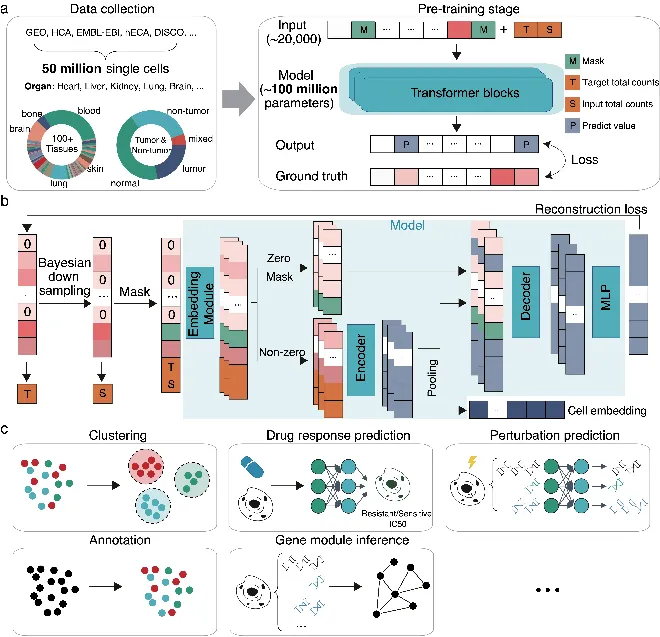
As we are well aware, the language model has sparked a new revolution by assimilating vast amounts of textual data and acquiring the prowess to comprehend and discern language. In recent times, scientists have begun to view the DNA sequences, gene expressions, and other cellular attributes within the realm of life sciences as a form of cellular "language." Leveraging this conceptualization, an artificial intelligence-driven cellular macro model has been ingeniously developed, serving as a groundbreaking tool in the exploration of biological complexities.
The researchers from the Department of Automation, the Department of Electronic Engineering of Tsinghua University, and BioMap developed a large pretrained model scFoundation, also named ‘xTrimoscFoundationα’, with 100 million parameters covering about 20,000 genes, pretrained on over 50 million human single-cell transcriptomic profiles. As a base model, it has demonstrated excellent performance enhancement in a variety of biomedical downstream tasks such as "virtual drug trials", providing a new paradigm for AI in single-cell research.
The "language" of cells diverges significantly from natural language, presenting challenges that include the high dimensionality of features, as well as continuous and sparse values. The research team has designed a model architecture so that scFoundation can directly convert continuous gene expression values into vectors. To this end, the research team designed a model architecture so that the value encoding module of scFoundation can directly convert continuous gene expression values into vectors, and designed an asymmetric model architecture based on Transformer, which can significantly improve the computational efficiency while keeping the parameter scale unchanged. Considering the obvious differences in the quality of single-cell data, the team also designed a pre-training task to recover high-quality data from low-quality data, which further enhances the adaptability of the pre-trained model to downstream data from different sources.
2. Cell Discovery丨Adding a "Lock" to This Neuron to Alleviate Emotion-induced Insomnia
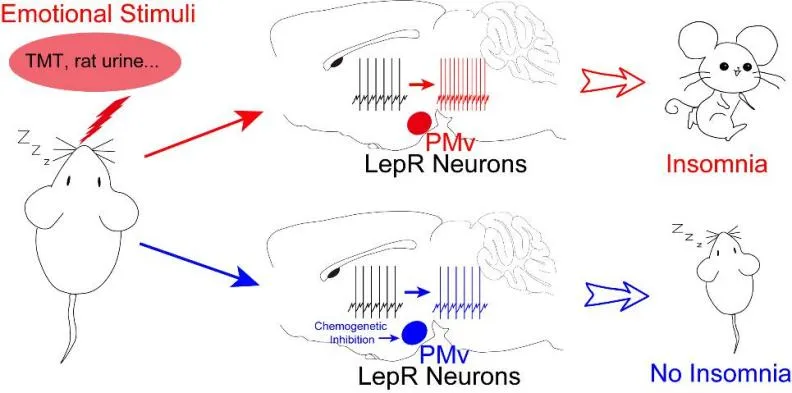
Neural mechanisms of emotional insomnia. Administration of different emotional stimuli to mice activates PMvLepR neurons and causes increased arousal; chemogenetic inhibition of PMvLepR neurons eliminates the elevated arousal induced by emotional stimuli.
Throughout one's life, moments inevitably arise when feelings of unhappiness, intense stress, and excessive rumination culminate in insomnia or compromised sleep quality. Scientifically speaking, this type of short-term sleep disorder triggered by emotional stimuli or external stress is referred to as emotional insomnia. It manifests as difficulty falling asleep, maintaining sleep, or early morning awakenings, accompanied by symptoms such as daytime fatigue, difficulty concentrating, and emotional instability. Transient emotional insomnia is particularly common, with as many as 80% of people having experienced it at some point.
The research team led by HUANG Zhilin from Fudan University, in collaboration with scientists YUAN Xiangshan, LI Wensheng, and others from the Department of Human Anatomy, Histology, and Embryology, has not only identified the key neurons responsible for triggering emotional insomnia but has also devised a method to "lock" them. The ventral preoptic nucleus (PMv) is a crucial brain region for integrating olfactory stimulus information. Within the PMv, there exists a significant population of neurons expressing the leptin receptor (LepR), which can be selectively activated by chemical pheromones.
Through their experiments, the researchers found that activation of LepR neurons mimicked the onset of emotional insomnia, while inhibition of PMvLepR neurons alleviated the symptoms of emotionally induced insomnia in mice. Their work highlights the pivotal role of PMv in emotion-induced insomnia and suggests that PMvLepR neurons may be an important therapeutic target for managing emotion-induced insomnia. This study not only provides new clues and perspectives for understanding the complex relationship between emotions and sleep, but also lays the foundation for developing new methods for treating emotional insomnia.
3. Advanced Materials丨Reducing Commercial Costs of Optical Waveguide Amplifiers: A Technique with Double Benefits
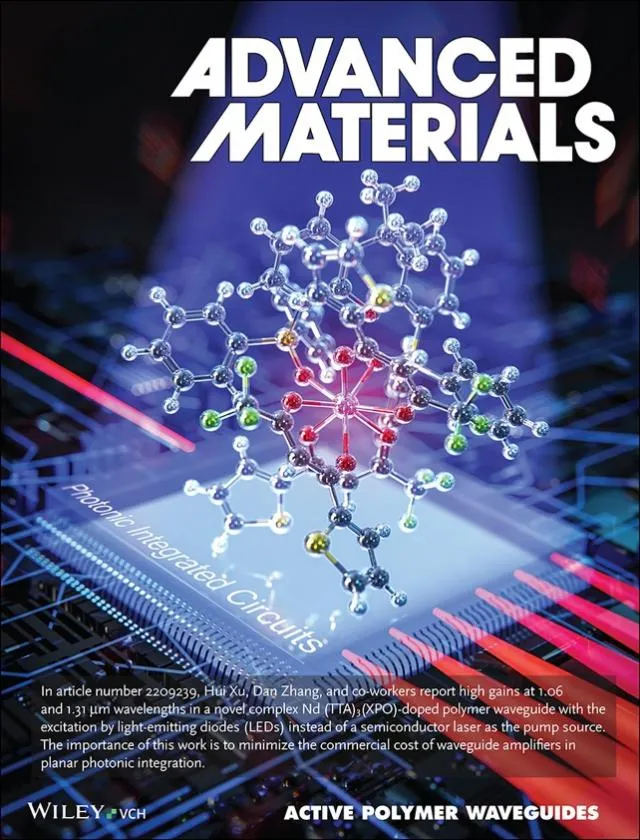
Rare-earth-doped optical waveguide amplifiers play a pivotal role in integrated photonic chips, serving as crucial photonic components to counteract various forms of optical attenuation. Typically, these devices harness lasers as their pumping source, exploiting the inherent absorption and radiative transitions of rare-earth ions to achieve optical amplification. Nevertheless, the reliance on laser pumping exposes the waveguide to the risk of thermal degradation and triggers upconversion luminescence in rare-earth ions. Furthermore, the commercialization of these devices incurs substantial costs and constrains their adaptability for seamless integration into silicon-based photonic chips. Consequently, these challenges have impeded the scalability of rare-earth-doped optical waveguide amplifiers for large-scale planar photonic integration.
The team led by ZHANG Dan from the College of Electronic Science and Technology at Xiamen University and XU Hui's team from the School of Chemistry, Chemical Engineering and Materials Science at Heilongjiang University have synthesized a neodymium complex, Nd(TTA)3(XPO). Through the intramolecular energy transfer between the organic ligands and the central rare-earth neodymium ion, they have achieved highly efficient luminescence of the neodymium ion at two near-infrared wavelengths, 1.06 µm and 1.31 µm.
Based on intramolecular energy transfer mechanism, optical gains at 1.06 and 1.31 µm are demonstrated in Nd (TTA)3 (XPO)-doped polymer waveguides with the excitation of low-power light-emitting diodes (LEDs) instead of semiconductor lasers as pump sources.
Additionally, they have designed and fabricated two types of silicon-based optical waveguide devices with stripe and evanescent wave structures. By substituting traditional lasers with low-power light-emitting diodes as the pumping source, they have achieved an optical gain of 22.5 dB/cm at a wavelength of 1.06 µm, which represents the highest reported gain for organic optical waveguide amplifiers at this wavelength. Concurrently, the devices have attained an optical gain of 8.4 dB/cm at a wavelength of 1.31 µm, marking the first breakthrough for such devices in achieving high-gain optical amplification within the O-band of optical communications.
This research ingeniously combines intramolecular energy transfer theory with LED pumping technology, achieving for the first time high gain at dual near-infrared wavelengths under the excitation of a low-power LED pump, aptly described as "killing two birds with one stone." The study significantly reduces the commercialization costs of optical waveguide amplifiers, aligns with the development trend of dense wavelength division multiplexing technology, and propels the industrialization of organic optical waveguide amplifiers in silicon photonic interconnection and integration.
4. Chemical Engineering Journal丨Novel, Ultrasensitive Diagnostic Tool for Cancer Markers Debuts
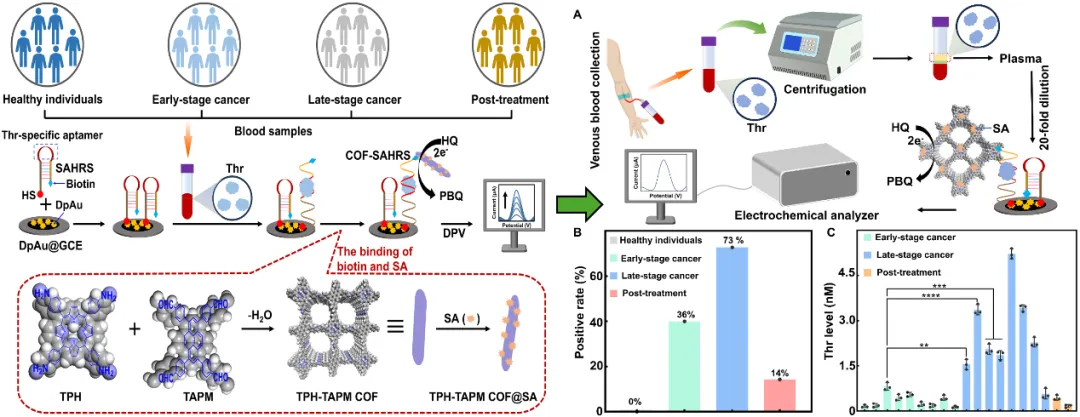
Thrombin is associated with malignant tumors and promotes tumor development, metastasis, and angiogenesis. The ultrasensitive detection of thrombin (Thr) is of significant importance for cancer diagnosis. The team led by WANG Jin from the School of Public Health at Southeast University has developed a novel, simple, and ultrasensitive electrochemical aptamer sensor for thrombin detection, known as COF-SAHRS. As the name suggests, this sensor is the innovative combination of a single-hairpin DNA response system (SAHRS) and a covalent organic framework (COF)-mediated electrochemical biosensor.
Under optimal conditions, the COF-SAHRS sensor exhibits a low detection limit of 0.17 pM and a linear range from 10 pM to 20 nM. In a thrombin spiked recovery experiment, the recovery rate ranged from 95.4% to 104.8%, validating the accuracy of this analytical method. Analysis of blood samples from 50 cancer patients showed that the thrombin levels in advanced cancer patients were significantly higher than those in early-stage cancer patients, indicating that the developed electrochemical aptamer sensor provides a feasible diagnostic tool for detecting cancer and related protein biomarkers in clinical research.
5. Science丨A New Type of Sliding Ferroelectric Material with Inherent Fatigue Resistance
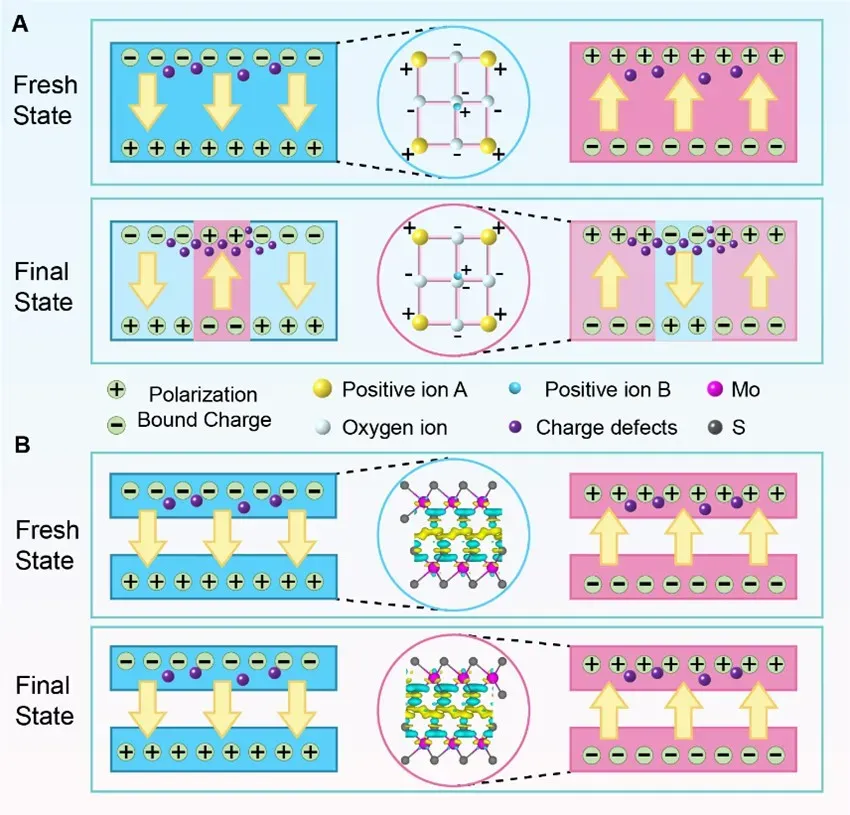
Ferroelectrics, with spontaneous polarization that can be modulated by external fields, are considered to be the ideal material system for the realization of brain-like intelligent devices and memory-computing integrated architectures. The realization of robust and repeatable "read" and "write" cycle operations is an essential prerequisite for ferroelectric device applications. However, after repeated polarization switching, the polarization of ferroelectric materials can only be partially reversed, which leads to ferroelectric material failure, i.e., ferroelectric fatigue.
This phenomenon arises because, when the ferroelectric material undergoes cyclic loading in an external field, the electrodeposition flip is invariably accompanied by the migration of defect charges. Over time, these defects coalesce into clusters under sustained exposure to the external field. These defect clusters exert a potent pinning effect on the ferroelectric domains, significantly curtailing their mobility. Once the domain boundaries become pinned, the polarization becomes resistant to flipping, ultimately culminating in the fatigue failure of the ferroelectric device. Despite the fact that this issue was identified and documented as far back as 1953, a comprehensive solution has yet to be achieved.
The team of LIU Fucai at the School of Optoelectronic Science and Engineering, University of Electronic Science and Technology (UEST), has discovered a new type of sliding ferroelectric material with inherent fatigue resistance. The ion displacement mechanism of slip ferroelectrics is significantly different from that of conventional ferroelectric materials. Under the action of an electric field, the layers of the slip ferroelectric van der Waals laminar material produce overall slip, charge transfer, and out-of-plane polarization flip between the layers.
Following millions of fatigue tests, the transfer characteristic curves and the dynamic and static electrical transport curves of sliding ferroelectric devices remain virtually unchanged, indicating exceptional fatigue resistance. In contrast to conventional ferroelectric materials, sliding ferroelectrics can be polarized and flipped through interlayer slippage under a minuscule electric field, insufficient to induce the migration of charged defects. This unique mechanism underscores their remarkable durability and reliability in electrical applications.
In addition, due to the van der Waals laminar structure of 2D materials, defects are difficult to move across the layers and are more difficult to aggregate, and therefore do not produce ferroelectric fatigue. The research results provide an ideal solution to the problem of ferroelectric material fatigue, as well as new options for the application of ferroelectric materials in novel devices such as non-volatile memories, memory-computer integrated devices and brain-like computing chips.
Columnist: Li Xiaoxiao
Translator: Liu Kaiyuan